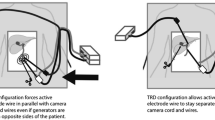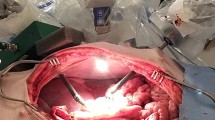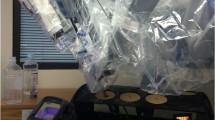Abstract
Background
The purpose of this study was to compare histologic evidence of thermal injury at the epigastric and umbilical incisions after elective laparoscopic cholecystectomy performed using the monopolar “Bovie” instrument set on the higher voltage coag mode versus the lower voltage blend mode. We hypothesized that the higher voltage coag mode would create more unintended thermal tissue injury at the epigastric trocar’s incision.
Methods
A prospective blinded randomized controlled trial of patients undergoing elective laparoscopic cholecystectomy was performed. Patients were randomized to have their operation performed with the monopolar instrument set at 30 W on either the coag mode or the blend mode. Immediately at the end of the operation, a biopsy sample of skin was obtained from the lower edge of the epigastric incision (through which the monopolar instrument was inserted) and the umbilical incision (through which the camera/telescope was inserted). The outcomes measured were histologic evidence of thermal injury at the epigastric and umbilical incisions (determined by a blinded pathologist).
Results
Forty patients were randomized (20 per group). Baseline demographics in the two groups were similar for age, gender, body mass index, preoperative diagnosis, operative time, and blood loss. Unintentional thermal injury was found at 20 % of epigastric incisions and 35 % of umbilical incisions in the total group. The incidence of thermal injury was higher after operations using the coag mode compared to the blend mode at both the epigastric (35 vs. 5 %; p = 0.044) and umbilical (55 vs. 15 %; p = 0.019) trocar incisions.
Conclusions
Radiofrequency energy from the monopolar Bovie instrument causes unintentional thermal injury to skin adjacent to the epigastric and umbilical trocar incisions. The incidence of thermal injury was reduced by using the lower voltage blend mode compared to the coag mode at both the epigastric and umbilical trocar incisions. Registration number: NCT016648060 (www.clinicaltrials.gov).



Similar content being viewed by others
References
Hulka JF, Levy BS, Parker WH, Phillips JM (1997) Laparoscopic-assisted vaginal hysterectomy: American association of gynecologic laparoscopists’ 1995 membership survey. J Am Assoc Gynecol Laparosc 4:167–171
Nduka CC, Super PA, Monson JR, Darzi AW (1994) Cause and prevention of electrosurgical injuries in laparoscopy. J Am Coll Surg 179:161–170
Wu MP, Ou CS, Chen SL, Yen EY, Rowbotham R (2000) Complications and recommended practices for electrosurgery in laparoscopy. Am J Surg 179:67–73
IEEE (2009) American national standard dictionary of electromagnetic compatibility (EMC) including electromagnetic environmental effects (E3). Institute of Electrical and Electronics Engineers (IEEE), Washington
Willson PD, van der Walt JD, Moxon D, Rogers J (1997) Port site electrosurgical (diathermy) burns during surgical laparoscopy. Surg Endosc 11:653–654
IEEE (2005) IEEE guide for instrumentation and control equipment grounding in generating stations. Institute of Electrical and Electronics Engineers (IEEE), Washington
Robinson TN, Pavlovsky KR, Looney H, Stiegmann GV, McGreevy FT (2010) Surgeon-controlled factors that reduce monopolar electrosurgery capacitive coupling during laparoscopy. Surg Laparosc Endosc Percutan Tech 20:317–320
Schulz KF, Altman DG, Moher D (2010) CONSORT 2010 statement: updated guidelines for reporting parallel group randomized trials. Ann Intern Med 152:726–732
Strasberg SM, Brunt LM (2010) Rationale and use of the critical view of safety in laparoscopic cholecystectomy. J Am Coll Surg 211:132–138
Voyles CR, Tucker RD (1992) Education and engineering solutions for potential problems with laparoscopic monopolar electrosurgery. Am J Surg 164:57–62
Robinson TN, Barnes K, Govekar HR, Stiegmann GV, Dunn C, McGreevy FT (2012) Antenna coupling: a novel mechanism of radiofrequency electrosurgery complication: practical implications. Ann Surg 256(2):213–218
Jones EL, Robinson TN, McHenry JR, Dunn CL, Montero PN, Govekar HR, Stiegmann GV (2012) Radiofrequency energy antenna coupling to common laparoscopic instruments: practical implications. Surg Endosc 26:3053–3057
Feder BJ (2006) Surgical device poses a rare but serious peril. Blackwell, Malden
Disclosures
J. Bruce Dunne, PhD, is a current employee of Covidien. Dr. Dunne leads the histology group that provided the blinded histology for the trial. Thomas N. Robinson, MD, has received honoraria for teaching the topic of electrosurgery from ConMed Electrosurgery and Covidien. He has received education Grants from Gyrus and Karl Storz Endoscopy and a research Grant from Medtronic, Inc. Drs. Edward L. Jones, Nicole Townsend, Teresa S. Jones, Paul N. Montero, Henry R. Govekar, and Greg V. Stiegmann, and Christina Dunn, BA, have no conflicts of interest or financial ties to disclose.
Author information
Authors and Affiliations
Corresponding author
Rights and permissions
About this article
Cite this article
Jones, E.L., Dunn, C.L., Townsend, N.T. et al. Blend mode reduces unintended thermal injury by laparoscopic monopolar instruments: a randomized controlled trial. Surg Endosc 27, 4016–4020 (2013). https://doi.org/10.1007/s00464-013-3032-2
Received:
Accepted:
Published:
Issue Date:
DOI: https://doi.org/10.1007/s00464-013-3032-2




